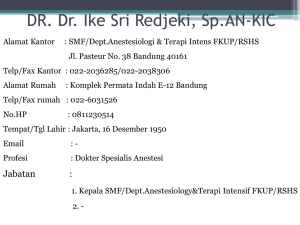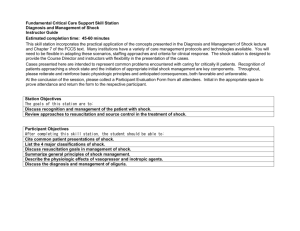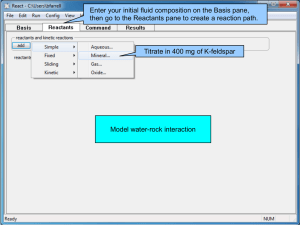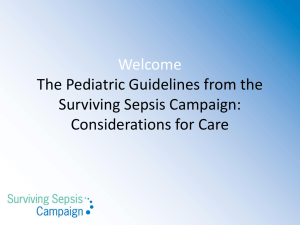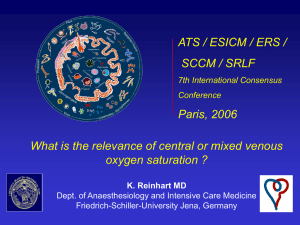Fluid Management and Shock Resuscitation
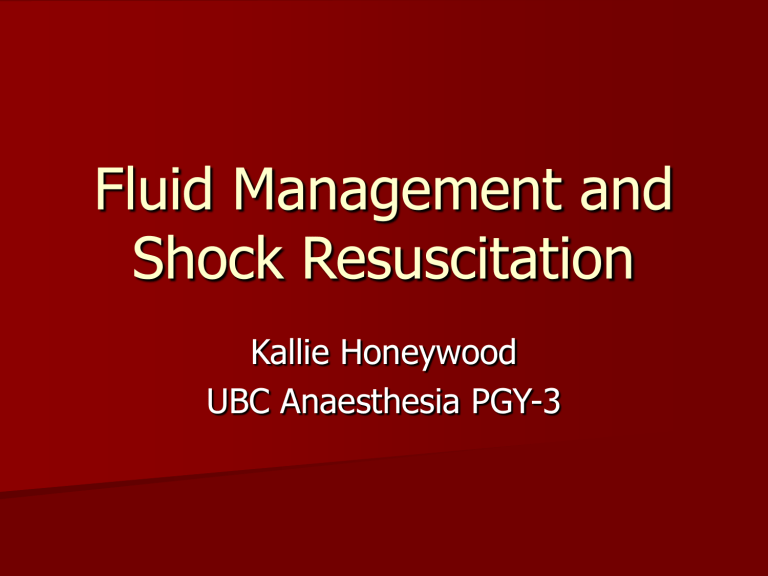
Fluid Management and
Shock Resuscitation
Kallie Honeywood
UBC Anaesthesia PGY-3
Outline
Normal Fluid Requirements
Definition of Shock
Types of Shock
– Hypovolemic
– Cardiogenic
– Distributive
– Obstructive
Resuscitation Fluids
Goals of Resuscitation
Body Fluid Compartments
Total Body Water = 60% body weight
– 70Kg TBW = 42 L
2/3 of TBW is intracellular (ICF)
– 40% of body weight, 70Kg = 28 L
1/3 of TBW is extracellular (ECF)
– 20% of body weight, 70Kg = 14 L
– Plasma volume is approx 4% of total body weight, but varies by age, gender, body habitus
Premature Infant
Term Infant
Slim Male
Obese Male
Slim Female
Obese Female
Blood Volume
Blood Volume (mL/kg)
90
80
75
70
65
60
Peri-operative Maintenance Fluids
Water
Sodium
Potassium replacement can be omitted for short periods of time
Chloride, Mg, Ca, trace minerals and supplementation needed only for chronic
IV maintenance
Most commonly Saline, Lactated Ringers,
Plasmalyte
4 – 2 – 1 Rule
100 – 50 – 20 Rule for daily fluid requirements
4 mL/kg for 1 st 10 kg
2 mL/kg for 2 nd 10 kg
1 mL/kg for each additional kg
Maintenance Fluids: Example
60 kg female
1 st 10 kg: 4 mL/kg x 10 kg = 40 mL
2 nd 10 kg: 2 mL/kg x 10 kg = 20 mL
Remaining:
60 kg – 20 kg = 40 kg
1 mL/kg x 40 kg = 40 mL
Maintenance Rate = 120 mL/hr
Fluid Deficits
Fasting
Bowel Loss ( Bowel Prep, vomiting, diarrhea )
Blood Loss
– Trauma
– Fractures
Burns
Sepsis
Pancreatitis
Insensible Fluid Loss
Evaporative
Exudative
Tissue Edema (surgical manipulation)
Fluid Sequestration (bowel, lung)
Extent of fluid loss or redistribution (the
“Third Space”) dependent on type of surgical procedure
Mobilization of Third Space Fluid POD#3
Insensible Fluid Loss
4 – 6 – 8 Rule
Replace with Crystalloid (NS, LR,
Plasmalyte)
Minor: 4 mL/kg/hr
Moderate: 6 mL/kg/hr
Major: 8 mL/kg/hr
Example
68 kg female for laparoscopic cholecystectomy
Fasted since midnight, OR start at 8am
Maintenance = 40 + 20 + 48 = 108 mL/hr
Deficit = 108 mL/hr x 8hr
= 864 mL
3 rd Space (4mL/kg/hr) = 272 mL/hr
Example
Intra-operative Fluid Replacement of:
– Fluid Deficit 864 mL
– Maintenance Fluid 108 mL/hr
– 3 rd Space Loss 272 mL/hr
– Ongoing blood loss (crystalloid vs. colloid)
Shock
Circulatory failure leading to inadequate perfusion and delivery of oxygen to vital organs
Blood Pressure is often used as an indirect estimator of tissue perfusion
Oxygen delivery is an interaction of
Cardiac Output, Blood Volume, Systemic
Vascular Resistance
Preload HR
Contractility
Afterload
SV
Hgb
PaO
2
Sat %
CO
CaO
2
DO
2
Types of Shock
Hypovolemic – most common
Hemorrhagic, occult fluid loss
Cardiogenic
Ischemia, arrhythmia, valvular, myocardial depression
Distributive
Anaphylaxis, sepsis, neurogenic
Obstructive
Tension pneumo, pericardial tamponade, PE
Hypovolemia
Cardiogenic -
LV
- RV
Distributive
Obstructive
Shock States
BP CVP PCWP CO SVR
Preload HR
Contractility
Afterload
SV
Hgb
PaO
2
Sat %
CO
CaO
2
DO
2
Hypovolemic Shock
Most common
Trauma
Blood Loss
Occult fluid loss (GI)
Burns
Pancreatitis
Sepsis (distributive, relative hypovolemia)
Assessment of Stages of Shock
% Blood
Volume loss
HR
< 15%
<100
15 – 30%
>100
30 – 40%
>120
>40%
>140
SBP N N, DBP, postural drop
Pulse
Pressure
Cap Refill
N or
< 3 sec
Resp
CNS
14 - 20 anxious
Treatment 1 – 2 L crystalloid, + maintenance
> 3 sec >3 sec or absent absent
20 - 30 30 - 40 v. anxious confused
2 L crystalloid, reevaluate
>35 lethargic
2 L crystalloid, re-evaluate, replace blood loss 1:3 crystalloid, 1:1 colloid or blood products. Urine output >0.5 mL/kg/hr
Fluid Resuscitation of Shock
Crystalloid Solutions
– Normal saline
– Ringers Lactate solution
– Plasmalyte
Colloid Solutions
– Pentastarch
– Blood products (albumin, RBC, plasma)
Crystalloid Solutions
Normal Saline
Lactated Ringers Solution
Plasmalyte
Require 3:1 replacement of volume loss
e.g. estimate 1 L blood loss, require 3 L of crystalloid to replace volume
Colloid Solutions
Pentaspan
Albumin 5%
Red Blood Cells
Fresh Frozen Plasma
Replacement of lost volume in 1:1 ratio
Oxygen Carrying Capacity
Only RBC contribute to oxygen carrying capacity (hemoglobin)
Replacement with all other solutions will
– support volume
– Improve end organ perfusion
– Will NOT provide additional oxygen carrying capacity
RBC Transfusion
BC Red Cell Transfusion Guidelines recommend transfusion only to keep Hgb
>70 g/dL unless
– Comorbid disease necessitating higher transfusion trigger (CAD, pulmonary disease, sepsis)
– Hemodynamic instability despite adequate fluid resuscitation
Crystalloid vs. Colloid
SAFE study (Saline vs. Albumin Fluid
Evaluation)
– Critically ill patients in ICU
– Randomized to Saline vs. 4% Albumin for fluid resuscitation
– No difference in 28 day all cause mortality
– No difference in length of ICU stay, mechanical ventilation, RRT, other organ failure
NEJM 2004; 350 (22), 2247- 2256
Goals of Fluid Resuscitation
Easily measured
– Mentation
– Blood Pressure
– Heart Rate
– Jugular Venous Pressure
– Urine Output
Goals of Fluid Resuscitation
A little less easily measured
– Central Venous Pressure (CVP)
– Left Atrial Pressure
– Central Venous Oxygen Saturation S
CV
O
2
Goals of Fluid Resuscitation
A bit more of a pain to measure
– Pulmonary Capillary Wedge Pressure (PCWP)
– Systemic Vascular Resistance (SVR)
– Cardiac Output / Cardiac Index
Mixed Venous Oxygenation
Used as a surrogate marker of end organ perfusion and oxygen delivery
Should be interpreted in context of other clinical information
True mixed venous is drawn from the pulmonary artery (mixing of venous blood from upper and lower body)
Often sample will be drawn from central venous catheter (superior vena cava, R atrium)
Mixed Venous Oxygenation
Normal oxygen saturation of venous blood
68% – 77%
Low S
CV
O
2
– Tissues are extracting far more oxygen than usual, reflecting sub-optimal tissue perfusion
(and oxygenation)
Following trends of S vasopressors)
CV
O
2 to guide resuscitation (fluids, RBC, inotropes,
Goals of Resuscitation
Rivers Study- Early Goal Directed Therapy in Sepsis and Septic Shock
– Emergency department with severe sepsis or septic shock, randomized to goal directed protocol vs standard therapy prior to admission to ICU
– Early goal directed therapy conferred lower
APACHE scores, incidating less severe organ dysfunction
Preload HR
Contractility
Afterload
SV
Hgb
PaO
2
Sat %
CO
CaO
2
DO
2
Bottom Line
Resuscitation of Shock is all about getting oxygen to the tissues
Initial assessment of volume deficit, replace that
(with crystalloid), and reassess
Continue volume resuscitation to target endpoints
Can use mixed venous oxygen saturation to estimate tissue perfusion and oxygenation
References
Clinical Anesthesia 3 rd Ed. Morgan et al.
Lange Medical / McGraw Hill, 2002
Anesthesiology Review 3 rd Ed. Faust, R.
Churchill-Livingstone, 2002
Rivers, E. et al. NEJM 2001; 345 (19):
1368 – 77
SAFE Investigators. NEJM 2004; 350:
2247 - 56

